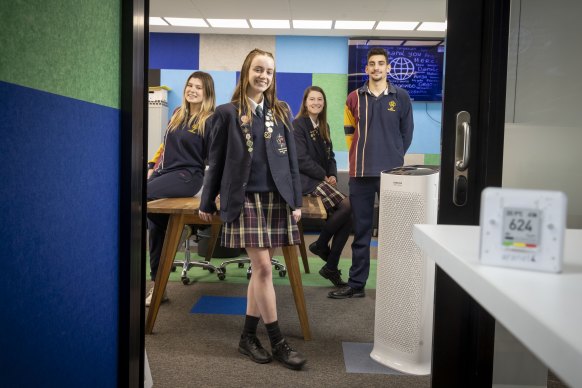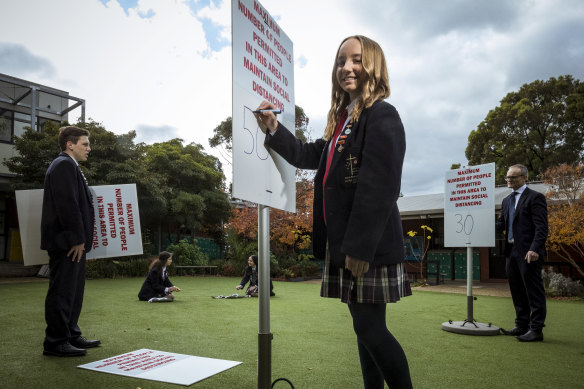By Nicole Precel and Adam Carey
Victorian schools are using everything from carbon dioxide monitors to extra jackets and remote learning to manage the risks and disruption of COVID-19 outbreaks.
As of Sunday, there were 71,392 active COVID-19 cases in Victoria – and numbers are expected to increase. Education Minister Jason Clare has called a roundtable discussion for August 12 to address the national teacher workforce shortage.

Grace Plecas, 17, Isabel Hrvatin, 17, Jade Simunija,18, and Jaiden Calleja, 17, with one of the carbon dioxide monitors at Catholic Regional College in Sydenham.Credit: Wayne Taylor
Catholic Regional College principal Brendan Watson said alongside air purifiers, the school spent $40,000 on more than 50 carbon dioxide monitors for its Sydenham classrooms.
He said if carbon dioxide is too high, “there’s more likelihood there’ll be COVID in the air”. That is when they open windows and doors to increase ventilation.
“It’s not just COVID; there’s the flu, RSV [respiratory syncytial virus], which we’ve had some families come down with,” he said.
Independent Education Union Victoria deputy general secretary David Brear said some Catholic secondary schools were resorting to partial remote learning.
Watson said his school had been hit hard with COVID in the past fortnight. Last Wednesday, it had 26 staff away sick and year 11 students returned to remote learning for a day.
“There’s constantly COVID-19 around us. We’re trying to manage that; that’s not always possible to get casual relief teachers. Wednesday was a very bad day,” he said.
The week before, the school had three days of partial remote learning: year 11 students, except for Victorian Certificate of Applied Learning and vocational education and training students, worked from home on the Tuesday and Thursday; and year 12 students on the Wednesday.
“It’s the new norm. We don’t want to close down completely. We don’t want to be online, we want to be here. We are trying to all work together and that’s what’s going to get us through,” he said.
Catholic Education Commission Victoria executive director Jim Miles said schools were using a range of measures to provide safe learning environments, including ventilation and outdoor learning spaces “where practicable”.
Education Minister Natalie Hutchins said air purifiers had been distributed to Victorian schools, which provided good protection but “there was nothing better than having the window open”.
“Sometimes that is not practical when it’s 1 degree, like this morning, and if students and parents want to bring blankets along to stay warm, then that is fine,” she said.
Temperatures in Melbourne last week dropped below 1 degree, and for four days in a row it was below 5 degrees in the morning.
This week is forecast to be slightly warmer, with minimum temperatures between 9 degrees on Monday and 6 degrees on Friday.
Blackburn Primary School principal Andrew Cock said the school was running its air purifiers “all day and every day” and strongly encouraging families, as well as teachers, to wear masks.
He said while the school was not encouraging students to wear winter coats or bring blankets to school, it would not be challenging them if they did.
“When you have the last couple of days in some areas where it’s minus degrees, we wouldn’t have an issue if children are wearing an extra coat to keep themselves extra warm,” he said.
He said some teachers had windows open with the heating on, so “you didn’t require additional blankets or clothes, it was still quite warm”.
Australian Principals Federation president Tina King said schools were using combinations of air purifiers, masks, social distancing and ventilation, and she hoped “common sense” would prevail.
“If it’s zero degrees and windows and doors are open, and [students] are coming to school in shorts and a T-shirt, of course they are going to freeze. I know schools are making exceptions if children want to wear an added layer of clothing,” she said.
A Department of Education spokesperson said it was advising schools to take a “commonsense approach”, using air purifiers with heaters during winter months.
“Schools should not keep windows and doors open in these cold conditions – we have delivered more than 130,000 air purifiers to support schools to manage the risks of COVID while keeping staff and students comfortable,” they said.

Students at Catholic Regional College in Sydenham preparing for the return to school in 2020. Credit: Chris Hopkins
Schools have been advised to consider the weather before opening windows and doors, and to only do so for short periods during bad weather. “We will continue working with our schools to help reduce the spread of illness and ensure students remain in face-to-face learning.”
During term 3, schools will receive further supplies of N95 masks, surgical masks and child-size surgical masks. Rapid antigen tests will continue to be distributed in terms 3 and 4, and masks are strongly recommended in indoor settings at schools.
Associate Professor Margie Danchin, from Murdoch Children’s Research Institute, said she thought it was “extremely unlikely” opening windows or doors could lead to weakening of a child’s immune system enough to catch a virus.
“It’s not like they are sitting in the snow,” she said. “If it’ll improve ventilation in the classroom [then] it’s a really smart idea. We need to be using everything in our armoury right now.
“It’s about one, managing risk, and two, being sensible. If that means the room is absolutely freezing and the kids are so cold, despite blankets, that they can’t focus well, that’s clearly not a good idea. But if simply opening the window improves airflow and the kids are comfortable with blankets then I think that’s gold.”
The Morning Edition newsletter is our guide to the day’s most important and interesting stories, analysis and insights. Sign up here.